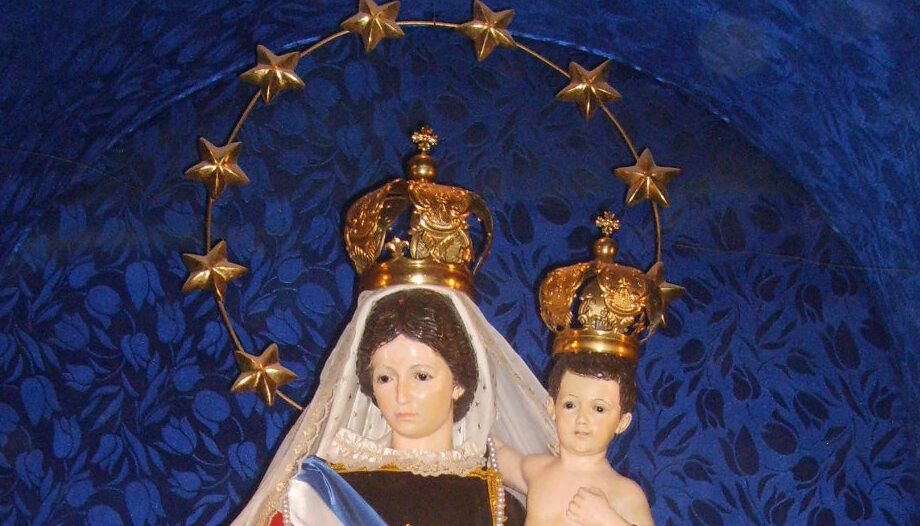The sanctuary of Nuestra Señora de la Tirana is one of the most famous in Chile. It dates back to the 16th century and its origins are related to the love story of an indigenous princess and a Spanish soldier.
The sanctuary of Lo Vásquez is another of the most important in the country and its festivities take place on December 8, the day of the Immaculate Conception.
Sanctuary of Nuestra Señora del Carmen of La Tirana
1800 km north of Santiago, the capital of Chile, in the middle of the Pampa del Tamarugal, is the town of La Tirana, with a population of only 840 inhabitants. In this desert landscape is located a famous sanctuary of the Virgin Mary called "La Tirana".
The sanctuary has its roots in the dawn of the Spanish conquest and the evangelization of the sixteenth century. Its origins are linked to the legend of an Inca princess, Ñusta Huillac, a woman who, according to history, was considered a "tyrant" because of her drastic decisions. Fleeing from Diego de Almagro's expedition, the feisty princess took refuge in the forests of the Tamarugal, where she became a leader, attacking the Spaniards who entered the forests. Ñusta Huillac took prisoner one of them, Vasco de Almeida, with whom she fell in love. This fact motivated her conversion to Christianity around 1540.
The truth about eternity and, with it, the prolongation of her love, strongly attracts her and she requests Baptism. For this reason she was considered a traitor and condemned to death together with Vasco de Almeida. At her request, and taking into account her high lineage, her executioners placed a cross on her tomb, which, years later, would be discovered by Friar Antonio de Rondón, who followed the expedition of Pedro de Valdivia.
The Hermitage
The clergyman built a hermitage in the place and placed an image of the Virgin, quickly becoming a place of worship to the Mother of the Lord by the indigenous people. It became a place where faith in Jesus Christ and love for the Virgin began to develop and be expressed. Family type dances were initiated and the cult was limited to those who lived in the area.
Thus, this devotion in the place begins to gain strength from the eighteenth century, when the number of parishioners who want to worship the Holy Virgin increases. The place receives the name of Pozo del Carmen de La Tirana or Pozo del Carmelo. However, the name was gradually shortened to "La Tirana".
Current devotion
In just one week, eleven months of silence and stillness are transformed into devotion, religiosity, songs and dances in this town. Between July 12 and 18, the Pampa del Tamarugal dresses up in its best clothes in honor of the Virgin of La Tirana. With a strong Christian and Andean influence, the celebration takes place between "diabladas", "Chinese dances", "morenadas" and "huaynos", in which more than 220,000 people visit the Virgin in demand of health, work and dignity.
Currently, about 200 dance troupes, mainly from the towns of Iquique, Pedro de Valdivia, Arica, María Elena and Antofagasta, come to the town to renew its spirit. The festival offers a series of characteristics such as the variety of "companies" or "brotherhoods", which intermingle with old, traditional and new dances, giving a carnival character to the celebration. On the night of July 15 to 16 -the solemnity of the Virgen del Carmen-, the attendees gather in the square to make "la espera del alba" or vigil. Then the national anthem is sung. On the same day, the Mass and the procession take place, where tens of thousands of faithful go to deliver offerings, entrust their children to the Virgin's care, etc. On the 17th the celebration ends with the farewell dances.
Unfortunately, because of the COVID pandemic, this ancient festival could not be held from 2020 to 2022. As the sanitary conditions have greatly improved, it is very likely that it will be able to take place this year.
Pilgrims at the Sanctuary of Lo Vasquez on December 8
The origins of the current Sanctuary of Lo Vásquez The first images of the Virgin Mary - 80 km from Santiago, the capital of the country - date back to the first half of the 19th century, in the family chapel of a hacienda located on the side of the road that links Santiago with Valparaíso. There, an image of the Blessed Virgin Mary. The parish archives of Casablanca contain the first baptisms performed by the parish priest in the Lo Vásquez Chapel in 1849.
The image of the Virgin was crowned in 1951 and the temple has been transformed into a beautiful sanctuary where Our Lady is venerated by thousands of Chileans. At present, the number of parishioners who congregate around December 8, the day of the Purisima, exceeds 800,000 people, becoming the most important Marian pilgrimage in the country, with the participation of many institutions. Many pilgrims walk dozens of kilometers from various cities and towns in central Chile to fulfill their "mandas" (promises) made to Our Lady for a favor granted. Many thousands come on this occasion to the Sacrament of Penance in the numerous confessionals that are installed in annexes to the temple and participate in the Masses that are celebrated almost without interruption for two days.








